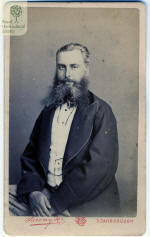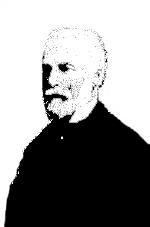|
Thomas Laxton
Bedfordshire, England
 Thomas
Laxton was born in Tinwell, Rutland, England in 1830.
Although he trained as a lawyer, his interests were in plant
hybridization.* By 1858, he was actively working with
breeding plants. Thomas
Laxton was born in Tinwell, Rutland, England in 1830.
Although he trained as a lawyer, his interests were in plant
hybridization.* By 1858, he was actively working with
breeding plants.
Mr. Laxton was one
of the first plant breeders to use the scientific method in the
development of new plant varieties. His experiments were
well documented and well regarded. His trials and
observations with peas aided Charles
Darwin in his writings.
As early as 1872,
he began introducing new strawberry varieties. This began
the most extensive, and continuous, strawberry breeding program
ever attempted in England at that time.
His first great success and the only variety
he introduced that was not a handmade cross was the 'Noble' (1884), a seedling
of 'Excelsior' that had been planted next to the 'American Sharpless'. Until the
last few years it was a major early variety of many countries. It was
notable for its earliness, its resistance to cold and to disease. Even as
late as
1960, many acres were still being grown in Italy and in Scandinavia.
'King of the Earlies'
('Vicomtesse Hericart de Thury' x 'Black Prince') was introduced in 1888. In
1892, Laxton's other great variety, 'Royal Sovereign', nearly equal to
'Keens Seedling' in significance, was released. It was a cross of 'Noble'
with 'King of the Earlies' and it had an American variety, 'Sharpless', in
its ancestry. The earliness, excellent flavor, beauty, productiveness,
hardiness and relatively good handling quality made it of great importance
in
 Great
Britain and throughout Europe. Its weaknesses are its great susceptibility
to mildew and to virus diseases. It was still being raised in many parts of
Europe into the late mid-20th Century. Great
Britain and throughout Europe. Its weaknesses are its great susceptibility
to mildew and to virus diseases. It was still being raised in many parts of
Europe into the late mid-20th Century.
Thomas Laxton originated seventeen
strawberry varieties
himself and after his sons took over the work in the 1890s, they along with
their sons introduced forty seven more. 'Scarlet Queen', 'Leader', 'Fillbasket',
'The Laxton', 'Latest', 'Latest of All', 'Bedford Champion' and 'Duke',
were some of the more notable of the other varieties.
Laxton understood the weaknesses
of European varieties better than other breeders in the 19th century. The
European varieties were not hardy and needed to be
hybridized with stronger American varieties. He once said that he had raised
at least 10,000 seedlings over his thirty two years of breeding strawberries.
By the time he had retired in
1890 he was living in Bedford. Throughout his career, his goal was to
introduce better plant varieties rather than making money. He had been
married twice, had three daughters from his first marriage and four sons
from his second. Thomas Laxton passed away in 1893.
Strawberries were not the
exclusive area of focus for the later Laxton generations. They also
released significantly improved apple, pear, plum and pea varieties,
such as the 'Thomas
Laxton' pea, among
other things. In their over 100 years of horticultural improvement
work, at least 180 different plant varieties are attributed to them.
After four generations and
family tragedies, the business and its assets were liquidated in 1957.
Sources:
-
Strawberry Improvement: Past and Future - USDA
-
The Laxton Family
* - It should be noted that
hybridization in the 19th Century context does not imply some sinister or
ulterior motive as modern 21st Century corporate driven hybridization
conjurs. Hybridization, using classical breeding methods following
natural law, is how all new varieties are developed. The difference is
that in this older, purer context, varieties are not released as unstable,
first generation (F1) hybrids. They are bred, grown, and selected out
over several generations until they become stable, true-to-type and uniquely
new varieties.
Referenced:
"So, again, Mr. Laxton, who
has had such great experience in crossing peas, writes to me that "whenever
a cross has been effected between a white-blossomed and a purple- blossomed
pea, or between a white-seeded and a purple-spotted, brown or maple- seeded
pea, the offspring seems to lose nearly all the characteristics of the
white-flowered and white-seeded varieties; and this result follows whether
these varieties have been used as the pollen-bearing or seed-producing
parents."
"The Variation of Animals
and Plants Under Domestication. Volume II," Charles Darwin
"Recently
Mr. Laxton has made numerous crosses, and everyone had been astonished at
the vigour and luxuriance of the new varieties which he has thus raised and
afterwards fixed by selection. He gave me seed-peas produced from crosses
between four distinct kinds; and the plants thus raised were extraordinarily
vigorous, being in each case from 1 to 2 or even 3 feet taller than the
parent-forms, which were raised at the same time close alongside."
"The Effects of Cross and
Self-Fertilisation in the Vegetable Kingdom," Charles Darwin
|